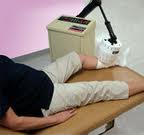Diathermy

In the realm of natural sciences, diathermy refers to "electrically induced
heat" and is frequently employed for muscle relaxation. It serves as a
method of electromagnetically or ultrasonically heating tissue for
therapeutic purposes in the medical field.
Diathermy involves utilizing high-frequency electromagnetic currents for
physical therapy and surgical procedures. The term originates from the Greek
words "dia" and "therma," meaning "heating through."
In physical therapy, diathermy administers controlled heat directly to
pathological lesions in deeper body tissues. In surgery, the intense heat
generated by diathermy may be utilized to eradicate neoplasms, warts, and
infected tissues, as well as to cauterize blood vessels and prevent
excessive bleeding. This technique holds particular significance in
neurosurgery and ophthalmic surgery.
Physical therapists typically employ three forms of diathermy: short wave,
ultrasound, and microwave. By applying moderate heat, diathermy enhances
blood flow, accelerates metabolism, and promotes ion diffusion across
cellular membranes. Heat facilitates the stretching of fibrous tissues in
tendons, joint capsules, and scars, thereby alleviating joint stiffness and
inducing muscle relaxation while reducing muscle spasms.
Short wave diathermy machines feature two condenser plates positioned on
either side of the treatment area. Alternatively, induction coils, which are
flexible and adaptable, can conform to the body part undergoing treatment.
As high-frequency waves pass through body tissues between the condensers or
coils, they convert into heat. The intensity and depth of penetration of the
heat depend partly on the absorptive and resistance properties of the
encountered tissues.
The Federal Communications Commission regulates the frequencies permitted
for short wave diathermy operations, which include 13.66, 27.33, and 40.98
megahertz. Most commercial machines operate at a frequency of 27.33
megahertz and a wavelength of 11 meters.
Short wave diathermy is commonly prescribed for treating deep muscles and
joints covered by dense soft tissue masses, such as the hip. Additionally,
it may be applied to target localized deep inflammatory processes, as
observed in pelvic inflammatory disease.
undo Medical Equipment